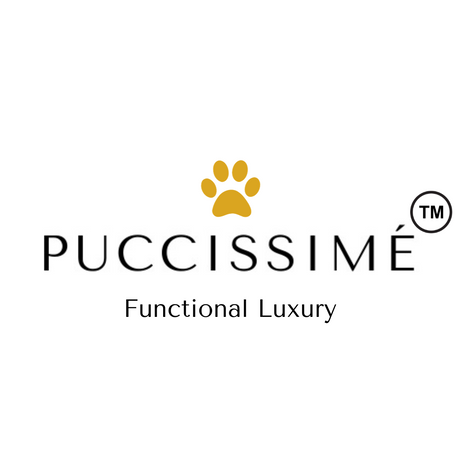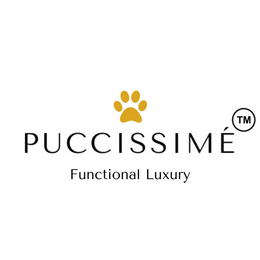What Material Is Best for Dog Harnesses and Collars?
Picking the right harness or collar isn’t just about form or fashion — it’s about your dog’s comfort, safety, and health. The material you choose can make a big difference in how your dog feels on a walk or during a day out.
But what happens if you choose the wrong material? It can chafe their skin, cause matting in their fur, or even break at the worst possible moment. Some materials also absorb bad odours over time.
Let’s break down the most common materials used in dog gear — and which ones are actually worth your money.
What Materials Are Common — and Which Ones Are Best?
There are a handful of materials that pet manufacturers love to use: Nylon, Real Leather, PU Leather (also called Vegan Leather), Polypropylene Webbing, and Cotton or Fabric-Based Materials. Each has its pros and cons, and some are better suited to certain dogs than others.
At Puccissimé Pet Couture, we want to explain which materials are safest and most comfortable for dogs.
1. Nylon: Affordable and Strong, But Not Always Gentle
Nylon is a synthetic polymer used in many types of apparel and consumer goods. Pet gear manufacturers often choose it because it’s lightweight, affordable, and, most importantly for dog owners, very durable.
But while nylon is strong, it also has downsides. It can cause matting or chafing, especially for long-haired dogs or during extended wear. Nylon harnesses also tend to trap odours over time, which means you may need to replace them every 1–2 years.
So, if your dog is very active, travels often, and has long hair, nylon might not be the best option. It’s popular for a reason — but comfort isn’t always its strong suit, especially for daily or all-day wear.
2. Real Leather: Durable and Stylish—but Needs Maintenance
Real leather has that classic, polished look that never goes out of style. It’s strong, durable, and easy to clean. That said, it does require a bit of care to keep it looking and feeling great. If left unused or unconditioned, it can dry out and crack.
At Puccissimé Pet Couture, we use real leather because it’s long-lasting and feels good for the dog — thanks to the added layers of webbing and cushion foam underneath. This extra padding protects your dog’s skin and fur from rubbing or irritation.
However, real leather does require some care. If it’s not cleaned and maintained regularly, it can dry out, stiffen, or crack. It’s also more expensive than other options, but it’s an investment that can last for years with proper care.
3. PU Leather (Vegan Leather): Soft, Sleek, and Eco-Friendly
PU (polyurethane) leather or Vegan Leather is a synthetic material that mimics the look and feel of real leather. It’s a popular vegan alternative that’s soft, stylish, and animal-friendly.
Vegan leather is gentle on your dog’s skin and offers a nice balance between form and function. It’s easy to clean and maintains a luxe look. However, it’s not quite as durable as real leather and can crack over time if neglected.
Still, if you’re looking for a fashionable, cruelty-free, and practical material, PU leather is a great choice — as long as you take care of it.

4. Polypropylene Webbing: The Hidden Strength
Polypropylene webbing is a lightweight, strong material made from thermoplastic polymer. It’s water- and chemical-resistant, and often used inside or beneath other materials to add strength without bulk.
You’ll find this material in many high-quality harnesses — it’s the hidden hero that helps gear hold its shape. While not quite as strong as nylon, polypropylene keeps its form well and doesn’t stretch easily.
However, on its own, it can feel a bit rough against the skin. Some dog owners choose it thinking it’s durable and budget-friendly, but if not combined with a softer layer, it could cause skin irritation.

5. Cotton or Fabric-Based Materials: Soft but Less Tough
Cotton is made from natural plant fibres and is known for being soft, breathable, and absorbent. It’s a great option for dogs with sensitive skin or allergies.
That said, cotton harness isn’t super durable. It’s best for small or calm dogs who don’t put too much wear and tear on their gear. For highly active dogs, cotton might wear out quickly. It also gets dirty and stained easily, so you’ll need to wash it often to keep it looking fresh.
What We Use at Puccissimé Pet Couture — and Why?
At Puccissimé, our harnesses and collars are made using a combination of PU leather and polypropylene webbing, or real leather, finished with zinc alloy hardware that won’t rust or break. We’ve also stopped using plastic to reduce our impact on the planet.
Why this mix?
-
PU leather provides a soft, stylish outer layer your dog will love.
-
Polypropylene webbing ensures strength and security underneath.
-
Zinc alloy hardware adds elegance and durability.
-
Cushion foam inside keeps your dog comfortable and prevents matting or chafing.
Our gear is handmade, easy to clean, and thoughtfully designed to be anti-choke, anti-pull, and anti-mat—built for real life and real dogs.
Final Thoughts
Choosing the right material means fewer problems, less replacing, and a happier dog on every walk. Here’s a quick guide:
-
Is your dog a puller? Choose something strong and secure, like webbing-backed PU leather.
-
Got a long-haired fluffball? Avoid rough nylon—opt for soft, anti-mat options.
-
Live in a rainy or snowy area? Waterproof materials like PU leather and webbing are ideal.
-
Is your pup sensitive or allergic? Go for breathable or vegan materials that are gentle on the skin.






Leave a comment